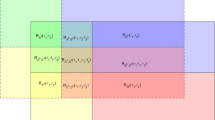Abstract
Multiuser hybrid beamforming of a wideband millimeter-wave (mm-wave) system is a complex combinatorial optimization problem. It not only needs large training data, but also tends to overfit and incur long run-time when multiple serial deep learning network models are used to solve this problem directly. Preferably, multitask deep learning (MTDL) model could jointly learn multiple related tasks and share their knowledge among the tasks, and this has been demonstrated to improve performance, compared to learning the tasks individually. Therefore, this work presents a first attempt to exploit MTDL for multiuser hybrid beamforming for mm-wave massive multiple-input multiple-output orthogonal frequency division multiple access systems. The MTDL model includes a multitask network architecture, which consists of two tasks-user scheduling and multiuser analog beamforming. First, we use the effective channel with a low dimension as input data for the two parallel tasks to reduce the computational complexity of deep neural networks. In a shallow shared layer of the MTDL model, we utilize hard parameter sharing in which the knowledge of multiuser analog beamforming task is shared with the user scheduling task to mitigate multiuser interference. Second, in the training process of the MTDL model, we use the exhaustive search algorithm to generate training data to ensure optimal performance. Finally, we choose the weight coefficient of each task by traversing all weight coefficient combinations in the training phase. Simulation results prove that our proposed MTDL-based multiuser hybrid beamforming scheme could achieve better performance than traditional algorithms and multiple serial single tasks deep learning scheme.
Similar content being viewed by others
References
Roh W, Seol J Y, Park J, et al. Millimeter-wave beamforming as an enabling technology for 5G cellular communications: theoretical feasibility and prototype results. IEEE Commun Mag, 2014, 52: 106–113
Bogale T E, Le L B. Massive MIMO and mmWave for 5G wireless HetNet: potential benefits and challenges. IEEE Veh Technol Mag, 2016, 11: 64–75
Ayach O E, Rajagopal S, Abu-Surra S, et al. Spatially sparse precoding in millimeter wave MIMO systems. IEEE Trans Wirel Commun, 2014, 13: 1499–1513
Sharma S K, Bogale T E, Le L B, et al. Dynamic spectrum sharing in 5G wireless networks with full-duplex technology: recent advances and research challenges. IEEE Commun Surv Tut, 2018, 20: 674–707
Samimi M K, Rappaport T S. Ultra-wideband statistical channel model for non line of sight millimeter-wave urban channels. In: Proceedings of IEEE Global Communications Conference (GLOBECOM), 2014. 3483–3489
Kwon G, Park H. A joint scheduling and millimeter wave hybrid beamforming system with partial side information. In: Proceedings of IEEE International Conference on Communications (ICC), 2016
He S W, Wu Y P, Ng D W K, et al. Joint optimization of analog beam and user scheduling for millimeter wave communications. IEEE Commun Lett, 2017, 21: 2638–2641
Jiang Z Y, Chen S, Zhou S, et al. Joint user scheduling and beam selection optimization for beam-based massive MIMO downlinks. IEEE Trans Wirel Commun, 2018, 17: 2190–2204
Jiang J, Kong D T. Joint user scheduling and MU-MIMO hybrid beamforming algorithm for mmWave FDMA massive MIMO system. Int J Antenna Propag, 2016, 2016: 1–10
Qin Z J, Ye H, Li G Y, et al. Deep learning in physical layer communications. IEEE Wirel Commun, 2019, 26: 93–99
Lu C, Xu W, Shen H, et al. MIMO channel information feedback using deep recurrent network. IEEE Commun Lett, 2019, 23: 188–191
He Y F, Zhang J, Wen C K, et al. TurboNet: a model-driven DNN decoder based on max-log-map algorithm for turbo code. 2019. ArXiv:1905.10502
Ruder S. An overview of multi-task learning in deep neural networks. 2017. ArXiv:1706.05098
Sun Y, Wang X G, Tang X O. Deep learning face representation by joint identification-verification. 2014. ArXiv:1406.4773
Alkhateeb A, El Ayach O, Leus G, et al. Channel estimation and hybrid precoding for millimeter wave cellular systems. IEEE J Sel Top Signal Process, 2014, 8: 831–846
Cai M M, Gao K, Nie D, et al. Effect of wideband beam squint on codebook design in phased-array wireless systems. In: Proceedings of IEEE Global Communications Conference (GLOBECOM), 2016
Wang B L, Jian M N, Gao F F, et al. Beam squint and channel estimation for wideband mmwave massive MIMO-OFDM systems. IEEE Trans Signal Process, 2019, 67: 5893–5908
Wang M J, Gao F F, Shlezinger N, et al. A block sparsity based estimator for mmwave massive MIMO channels with beam squint. IEEE Trans Signal Process, 2020, 68: 49–64
Caruana R. Multitask learning. Mach Learn, 1997, 28: 41–75
Nair V, Hinton G E. Rectified linear units improve restricted boltzmann machines. In: Proceedings of the 27th International Conference on Machine Learning (ICML-10), 2010. 807–814
Srivastava N, Hinton G F, Krizhevsky A, et al. Dropout: a simple way to prevent neural networks from overfitting. J Mach Learn Res, 2014, 15: 1532–4435
Kingma D, Ba J. Adam: a method for stochastic optimization. In: Proceedings of the 3rd International Conference on Learning Representations (ICLR), 2014
Acknowledgements
This work was supported by National Natural Science Foundation of China (Grant Nos. 61871321, 61901367), National Science and Technology Major Project (Grant No. 2017ZX03001012-005), and Shaanxi STA International Cooperation and Exchanges Project (Grant No. 2017KW-011).
Author information
Authors and Affiliations
Corresponding author
Rights and permissions
About this article
Cite this article
Jiang, J., Li, Y., Chen, L. et al. Multitask deep learning-based multiuser hybrid beamforming for mm-wave orthogonal frequency division multiple access systems. Sci. China Inf. Sci. 63, 180303 (2020). https://doi.org/10.1007/s11432-020-2937-y
Received:
Revised:
Accepted:
Published:
DOI: https://doi.org/10.1007/s11432-020-2937-y




